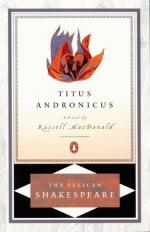|
This section contains 10,466 words (approx. 35 pages at 300 words per page) |

|
SOURCE: Bate, Jonathan. Introduction to Titus Andronicus, by William Shakespeare, edited by Jonathan Bate, pp. 1-122. London: Routledge, 1995.
In the following excerpted introduction, Bate surveys the structure, language, and critical reception of Titus Andronicus, and studies the drama's themes of revenge, passion, grief, and rape.
Space and Structure
The theatres built by the Elizabethans allowed for triple-layered performance. There was a gallery or upper stage (Juliet's window is the most famous use of this ‘above’ or ‘aloft’ space), the main stage which projected into the auditorium and on which the actors—in Hamlet's image—‘hold as 'twere the mirror’ up to the lives of the theatre audience, and the ‘cellarage’ below the stage, reached by a trap-door (through which Dr Faustus descends and the weird sisters' apparitions arise). In Titus Andronicus Shakespeare made bold and innovative use of all three levels.
Trumpets sound, heralding the beginning of the...
|
This section contains 10,466 words (approx. 35 pages at 300 words per page) |

|


